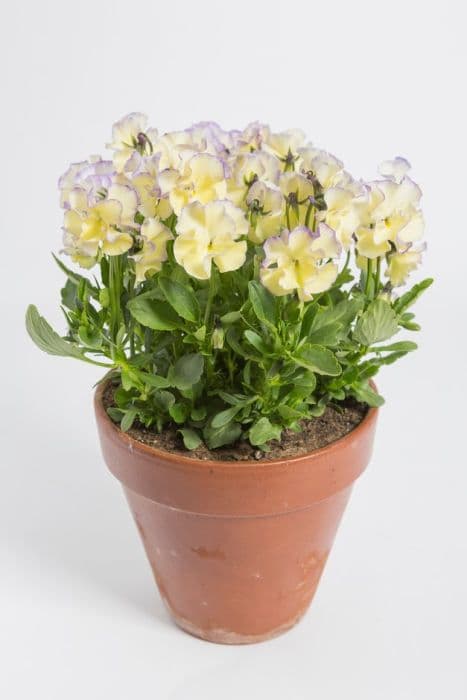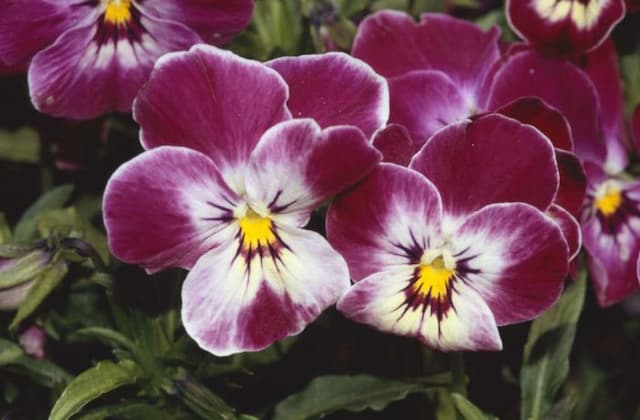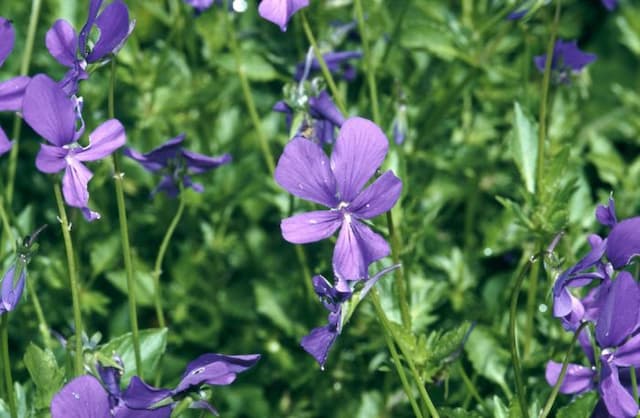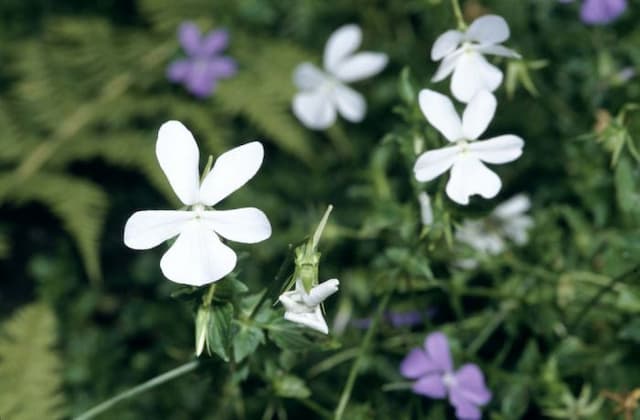Pansy Viola 'Conte di Brazza' (dPVt)
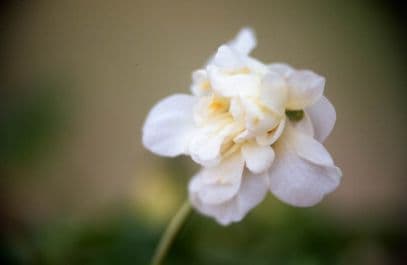
ABOUT
Viola 'Conte di Brazza' has a captivating appearance that makes it a favorite among garden enthusiasts. This variety of pansy boasts a stunning array of flowers that can really stand out in a garden setting. Its blooms are characterized by their unique color pattern, typically featuring a vibrant blend of hues that can include purples, yellows, blues, and whites. The petals are often rounded with slight ruffled edges and display a face-like center pattern that pansies are known for. The foliage of Viola 'Conte di Brazza' is equally attractive, with leaves that are generally heart-shaped and of a medium green color, providing a lush backdrop for the colorful blooms. Overall, the plant exudes a delicate charm and adds a touch of romance to any planting area it adorns.
About this plant
 Names
NamesFamily
Violaceae
Synonyms
Garden Violet, Sweet Violet, English Violet, Common Violet, Florist's Violet, Pansy
Common names
Viola 'Conte di Brazza'
 Toxicity
ToxicityTo humans
The Viola 'Conte di Brazza', commonly known as pansy, is generally considered to be non-toxic to humans. Ingesting parts of the plant typically does not lead to poisoning or serious consequences. However, it's always best to avoid eating any plant if you're not certain about its edibility or potential effects.
To pets
The Viola 'Conte di Brazza', commonly known as pansy, is also considered to be non-toxic to pets. It is not known to cause poisoning in animals such as dogs or cats if ingested. Therefore, there should be no toxic consequences for pets consuming this plant in small quantities. However, it's always prudent to discourage pets from eating non-food plants to avoid any potential upset stomach or other unpredictable reactions.
 Characteristics
CharacteristicsLife cycle
Perennials
Foliage type
Deciduous
Color of leaves
Green
Flower color
White
Height
0.5 feet (15 cm)
Spread
0.5 feet (15 cm)
Plant type
Herb
Hardiness zones
5
Native area
Europe
Benefits
 General Benefits
General Benefits- Ornamental Value: Viola 'Conte di Brazza', also known as viola, adds aesthetic appeal to gardens with its delicate and attractive flowers.
- Variety of Colors: It comes in a range of colors and patterns that can complement various garden designs.
- Seasonal Interest: Provides visual interest throughout its blooming season, which can be from early spring to late autumn, depending on the climate.
- Ground Cover: Its low-growing habit makes it suitable for ground cover, filling in spaces and reducing weed growth.
- Container Gardening: Well-suited for containers and hanging baskets, making it a versatile choice for those with limited garden space.
- Edible Flowers: Some varieties of viola flowers are edible and can be used to add color and a mild floral flavor to salads, desserts, and other dishes.
- Attracts Pollinators: Violas can attract butterflies and bees, supporting local ecosystems and pollination.
- Easy to Grow: They are generally easy to cultivate, making them suitable for gardeners of all skill levels.
- Propagation: They can be propagated through seeds or division, offering gardeners a cost-effective way to expand their plantings.
- Cold Tolerance: Many violas are cold-hardy plants, which can withstand cooler temperatures and even light frosts.
 Medical Properties
Medical PropertiesThis plant is not used for medical purposes.
 Air-purifying Qualities
Air-purifying QualitiesThis plant is not specifically known for air purifying qualities.
 Other Uses
Other Uses- Viola 'Conte di Brazza' can be used as a natural dye, offering subtle hues to fabrics and textiles.
- The petals of pansies can be crystallized and used as elegant cake decorations or to embellish desserts.
- The flower can be used in potpourri mixes to add a mild, sweet fragrance and a touch of color.
- As an educational tool, growing pansies can help children learn about plant life cycles and the basics of gardening.
- Pansies can be pressed and included in homemade paper to create a decorative effect.
- The flowers are sometimes used in the art of flower pounding to transfer their color and shape directly onto fabric.
- Pansy blooms can be frozen in ice cubes to add beauty to punches and other cold beverages at special events.
- When used in a compost heap, pansies contribute to nutrient-rich compost that benefits garden soil.
- The blossoms can serve as natural confetti for weddings and eco-friendly celebrations.
- Viola 'Conte di Brazza' plants can be used in companion planting to help deter certain pests from more vulnerable crops.
Interesting Facts
 Feng Shui
Feng ShuiThe Pansy is not used in Feng Shui practice.
 Zodiac Sign Compitability
Zodiac Sign CompitabilityThe Pansy is not used in astrology practice.
 Plant Symbolism
Plant Symbolism- Innocence: Violas have been commonly associated with innocence due to their small and delicate appearance.
- Simplicity: Their unassuming beauty and humble presence in gardens and wild settings symbolize the virtue of simplicity.
- Modesty: The way violas often have subtle colors and hide among other foliage represents modesty.
- Remembrance: In Victorian times, violas were used to convey the sentiment of remembering someone fondly.
- Love: The heart shape of the leaves has also made violas a symbol of love and affection.
- Healing: Herbal practices have used violas for their purported medicinal properties, making them symbolize healing.
 Water
WaterFor the pansy, known as Viola 'Conte di Brazza', it's important to maintain consistently moist soil without overwatering. They should be watered deeply when the top inch of the soil feels dry, usually about once a week, but frequency may increase to twice a week in hotter, drier conditions. Provide roughly 1 gallon of water per square yard of soil each watering session, ensuring even soil moisture. Avoid overhead watering to reduce the risk of foliar diseases, instead aiming the water at the base of the plants. During the winter months, reduce watering as the plant's growth slows and evaporation rates decrease.
 Light
LightPansies, including Viola 'Conte di Brazza', thrive in full to partial sunlight. The best location offers morning sunlight and afternoon shade, particularly in warmer climates to prevent the foliage from scorching. They can tolerate some light shade, but too much can lead to leggy plants and fewer blooms. Ideal lighting conditions include about 6 hours of direct sunlight daily.
 Temperature
TemperaturePansies like Viola 'Conte di Brazza' prefer cool temperatures and perform best when daytime temperatures are around 60 to 65 degrees Fahrenheit, and nighttime temperatures remain above freezing. They can survive short periods where temperatures drop down to about 20 degrees Fahrenheit, but prolonged exposure to extremes can be harmful. The ideal temperature range for pansies is 40 to 60 degrees Fahrenheit during their active growth periods in spring and fall.
 Pruning
PruningPrune pansies like Viola 'Conte di Brazza' to promote bushier growth and more blooms. Deadhead spent flowers regularly to encourage new buds to form. Cut back leggy stems in the spring or fall to revitalize plant appearance. The best time for major pruning is early spring or after the last frost, when the plant begins active growth.
 Cleaning
CleaningAs needed
 Soil
SoilViolas, commonly known as pansies, thrive in well-draining soil that is rich in organic matter. A mix containing peat, compost, and perlite or vermiculite is ideal. The soil pH should be slightly acidic to neutral, between 6.0 and 7.0, for the 'Conte di Brazza' to flourish.
 Repotting
RepottingPansies, including the 'Conte di Brazza', should be repotted annually, typically in the spring. Choose a larger pot if the plant shows signs of becoming root-bound or the soil is depleted.
 Humidity & Misting
Humidity & MistingPansies like Viola 'Conte di Brazza' prefer average to high humidity levels but are adaptable to a range of conditions. Ensuring good air circulation helps prevent issues in higher humidity environments.
 Suitable locations
Suitable locationsIndoor
Place pansies in bright, indirect light; avoid harsh sun.
Outdoor
Pansies prefer partial sun and rich, well-draining soil.
Hardiness zone
4-8 USDA
 Life cycle
Life cycleThe life of the Viola 'Conte di Brazza' (dPVt), commonly known as the pansy, begins with seed germination which occurs in a moist soil at cooler temperatures; young seedlings emerge with their first set of true leaves after cotyledons. As the seedlings grow, they develop a rosette of leaves at the soil level, and with proper light and moisture, they will begin to form sturdy stems and multiple leaves. The pansy enters the flowering stage, producing distinctive flowers with overlapping petals, often with a bold pattern or a single color, blooming typically in cooler weather of spring or fall. After pollination, often by insects, the pansy will set seed in small capsules, which when dried, will split open to release the seeds. These seeds can be dispersed by wind or rain, or collected for controlled propagation. Finally, pansies experience a period of senescence, where the plant will decline and die, completing its annual or biennial life cycle depending on the climate and growing conditions.
 Propogation
PropogationPropogation time
Spring to summer
Propogation: The Viola 'Conte di Brazza', more commonly known as pansy, is best propagated during cool, moist periods, which are typically in the spring or fall. The most popular method of propagation for pansies is through seed sowing. This involves planting the seeds in a well-draining soil mix, lightly covering them with soil, and maintaining a consistent moisture level without making the soil waterlogged. Once the seeds have germinated and the seedlings have grown their first true leaves, they can be carefully transplanted to their final location. The optimal soil temperature for germination is around 65 to 70 degrees Fahrenheit (18 to 21 degrees Celsius), and it usually takes about 1 to 2 weeks for the seeds to sprout.
